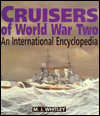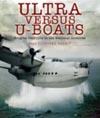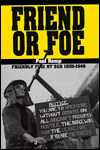Cruisers of World War Two
An International Encyclopedia
Whitley, M. J.
1996, United States Naval Inst.
ISBN 1557501416
Hardcover, 288 pages, 311 photographs, 82 drawings
| Type. | General history and ship specification book |
| Pros. | Good general discussion of the topic |
| Cons. | Poor proof editing allows too many errors to get through |
| Rating. |  |
 There is an old adage regarding baseball that one can't tell the players apart without a program. The same is true in naval history; one cannot really tell the ships and their key characteristics apart without the
equivalent of a program, which is a ship specification book. The concept behind M.J. Whitley's Cruisers of World War II: An International Encyclopedia is simple enough: to provide such a program by presenting a reasonable amount of information on the design philosophy and specifications of World War II cruisers, as well as a brief (few hundred word) service history of each ship. This should - in theory - give those interested in a specific ship or class of ships a general overview.
There is an old adage regarding baseball that one can't tell the players apart without a program. The same is true in naval history; one cannot really tell the ships and their key characteristics apart without the
equivalent of a program, which is a ship specification book. The concept behind M.J. Whitley's Cruisers of World War II: An International Encyclopedia is simple enough: to provide such a program by presenting a reasonable amount of information on the design philosophy and specifications of World War II cruisers, as well as a brief (few hundred word) service history of each ship. This should - in theory - give those interested in a specific ship or class of ships a general overview.
The level of detail in Cruisers of World War II is something like midway between that seen in a general work such as Conway's All the World's Fighting Ships 1922-1946 and country and design specific works on cruisers like Norman Friedman's U.S. Cruisers: An Illustrated Design History and Alan Raven and John Roberts' British Cruisers of World War Two.
The various cruisers of the world are organized in Whitley's book first by country and then by class. Neutral countries' ships are included. There is no general write-up for a specific country; Whitley provides a general introduction at the beginning of the book with other critical information included in the various class listings. These entries are divided into four parts: a listing of key information (construction yard and key dates, fate, armament, tonnage, engineering details etc.), and written descriptions of the class's design, modifications, and service history by ship. In addition, medium resolution drawings of most classes are included as are numerous photographs.
The "Design" section is just that, a discussion in up to several hundred words on the key design features and the thinking behind them. The information provided is enough for the casual reader, or to serve as the quick reference work which this book is intended to be. The "Modifications" section, meanwhile, describes changes made to ships of a class after completion. Generally these involve additional anti-aircraft armament and radar fitted during the war, though more major rebuilds are described if they occurred. Finally the "Service" section outlines the major events for each ship (where served, blockade runners captured, battles, final fate, etc.).
Unfortunately, the key words from above are "in theory", for Cruisers of World War II suffers from serious editing oversights that make the book difficult to use and greatly reduce its value as a reference work. Far too many glaring mistakes have gotten through into the final product. While the most obvious are the inclusion of the same picture twice on facing pages and the omission of service history information on HMS Bermuda, annoying small errors crop up with frightening regularity. A typical example is the drawing of the Japanese "Kinugasa 1943", which is quite remarkable given that she was sunk in October 1942! The ship history and fate listing, meanwhile, correctly state the date of loss. This is not an issue of the author's writing style - Whitley's prose is well crafted and his work generally well organized - but rather of proofing the material and making sure it is internally consistent. The truth can usually be discerned by carefully reading the text, but that shouldn't be the reader's responsibility. These inconsistencies creep into the ship characteristics as well, especially the information on armament placed prominently at the beginning of each entry. What is generally listed is the at-completion outfit, even if this changed before September 1, 1939, which seems a strange approach for a book titled Cruisers of World War II. However, in a number of cases subsequent additions are included, and the author's rationale in doing so or not doing so is far from clear.
Despite these challenges, this book is a useful basic reference work for those who have an eye for detail and will thus catch its annoying mistakes. For readers without such talents, the editing oversights and inconsistencies make it a trap that can easily confuse and misinform.
Review written by Michael Lowrey.
Published on 5 Aug 2000.
Purchase information: (info) Get Cruisers of World War Two now at amazon.co.uk
Get Cruisers of World War Two now at amazon.co.uk
Return to our main review page.



